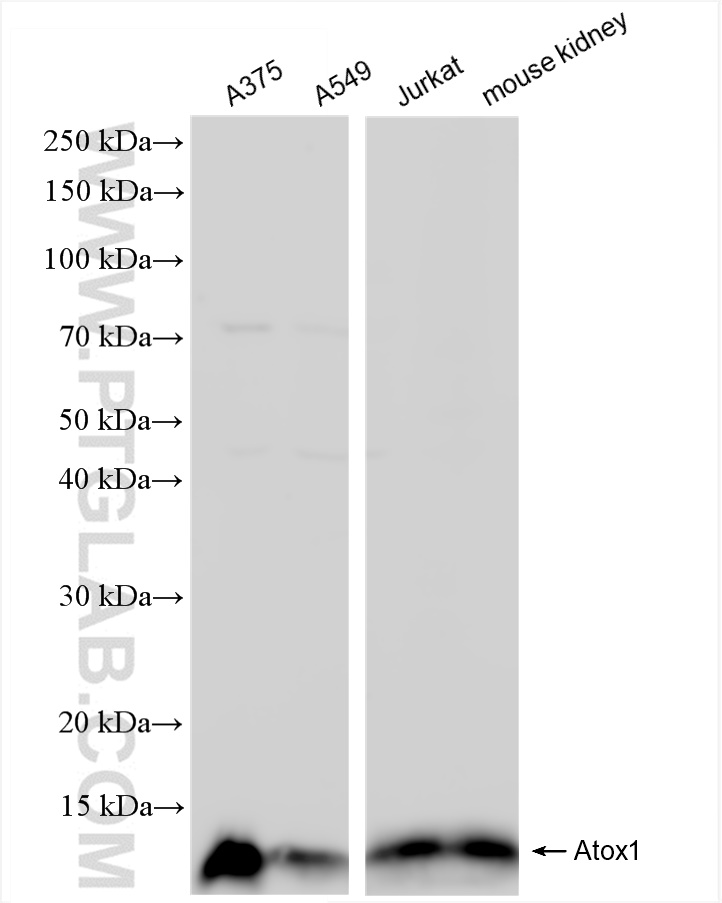验证数据展示
经过测试的应用
| Positive WB detected in | A375 cells, A549 cells, Jurkat cells, mouse kidney tissue |
| Positive IHC detected in | mouse heart tissue Note: suggested antigen retrieval with TE buffer pH 9.0; (*) Alternatively, antigen retrieval may be performed with citrate buffer pH 6.0 |
推荐稀释比
| 应用 | 推荐稀释比 |
|---|---|
| Western Blot (WB) | WB : 1:5000-1:50000 |
| Immunohistochemistry (IHC) | IHC : 1:50-1:500 |
| It is recommended that this reagent should be titrated in each testing system to obtain optimal results. | |
| Sample-dependent, Check data in validation data gallery. | |
产品信息
84305-1-RR targets Atox1 in WB, IHC, ELISA applications and shows reactivity with human, mouse samples.
| 经测试应用 | WB, IHC, ELISA Application Description |
| 经测试反应性 | human, mouse |
| 免疫原 |
CatNo: Ag35290 Product name: Recombinant mouse Atox1 protein Source: e coli.-derived, PGEX-4T Tag: GST Domain: 1-68 aa of NM_009720 Sequence: MPKHEFSVDMTCEGCAEAVSRVLNKLGGVEFNIDLPNKKVCIDSEHSSDTLLATLNKTGKAVSYLGPK 种属同源性预测 |
| 宿主/亚型 | Rabbit / IgG |
| 抗体类别 | Recombinant |
| 产品类型 | Antibody |
| 全称 | ATX1 (antioxidant protein 1) homolog 1 (yeast) |
| 别名 | HAH1, Atx1, 241566A7 |
| 计算分子量 | 7 kDa |
| 观测分子量 | 7 kDa |
| GenBank蛋白编号 | NM_009720 |
| 基因名称 | Atox1 |
| Gene ID (NCBI) | 11927 |
| RRID | AB_3671846 |
| 偶联类型 | Unconjugated |
| 形式 | Liquid |
| 纯化方式 | Protein A purification |
| UNIPROT ID | O08997 |
| 储存缓冲液 | PBS with 0.02% sodium azide and 50% glycerol, pH 7.3. |
| 储存条件 | Store at -20°C. Stable for one year after shipment. Aliquoting is unnecessary for -20oC storage. |
背景介绍
Antioxidant 1 copper chaperone (Atox1) is a small cytosolic protein containing an MBS (metal binding site) and a potential NLS (nuclear localisation signal). It plays an essential role in copper homeostasis by facilitating the transfer of copper to the trans-Golgi. Atox1 has been implicated in a wide range of diseases, including many neurodegenerative, cancer and metabolic disorders.
实验方案
| Product Specific Protocols | |
|---|---|
| IHC protocol for Atox1 antibody 84305-1-RR | Download protocol |
| WB protocol for Atox1 antibody 84305-1-RR | Download protocol |
| Standard Protocols | |
|---|---|
| Click here to view our Standard Protocols |



